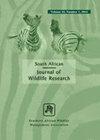Measuring Faecal Glucocorticoid Metabolite Concentrations as an Indicator of Stress in Blue Wildebeest (Connochaetes taurinus)
引用次数: 0
Abstract
In South Africa, blue wildebeest (Connochaetes taurinus) are routinely captured for relocation purposes. To monitor the stress caused by this practise, a non-invasive method assessing adrenocortical function as a measure of stress would minimize disturbance during sample collection. In our study, an adrenocorticotropic hormone challenge, and a mass-capture event were used to examine the suitability of five enzyme immunoassays (EIAs) for monitoring stress-related physiological responses using faeces as a sample matrix. The tested 11-oxoaetiocholanolone I EIA performed best, showing a 2126% increase above baseline after 22 h for a male, and a 474% increase for a female 23 h post-ACTH injection. Baseline faecal glucocorticoid metabolite (fGCM) concentrations did not differ between animals captured on either day 1 or day 2 of the capture event, indicating that the frequent presence of a helicopter during the two days did not influence fGCM concentrations. However, during capture-related restraint for up to 10 h, an overall 1.5-fold elevation in (fGCM) concentrations was found. Storage of faeces at ambient temperature post-defecation indicated a fair stability of fGCMs for up to 8 h. The ability to reliably assess adrenocortical function provides a solid basis to examine endocrine responses to putative stressful circumstances in blue wildebeest.测定蓝角马粪便糖皮质激素代谢物浓度作为应激指标
在南非,蓝角马(conchetes taurinus)通常被捕获用于搬迁目的。为了监测由这种做法引起的压力,一种评估肾上腺皮质功能的非侵入性方法作为压力的测量将最大限度地减少样品收集过程中的干扰。在我们的研究中,使用促肾上腺皮质激素刺激和大量捕获事件来检验五种酶免疫测定法(EIAs)用于监测压力相关生理反应的适用性,该方法使用粪便作为样本基质。注射acth后,11-氧代胆甾醇酮I的EIA表现最好,在注射acth后22小时,男性比基线增加2126%,女性比基线增加474%。基线粪便糖皮质激素代谢物(fGCM)浓度在捕获事件的第1天或第2天捕获的动物之间没有差异,这表明在两天内频繁出现直升机并不影响fGCM浓度。然而,在长达10小时的捕获相关限制期间,发现(fGCM)浓度总体升高1.5倍。排便后在环境温度下储存的粪便表明,fgcm的稳定性可达8小时。可靠评估肾上腺皮质功能的能力为研究蓝角马在假定的应激环境下的内分泌反应提供了坚实的基础。
本文章由计算机程序翻译,如有差异,请以英文原文为准。
求助全文
约1分钟内获得全文
求助全文

 求助内容:
求助内容: 应助结果提醒方式:
应助结果提醒方式:


